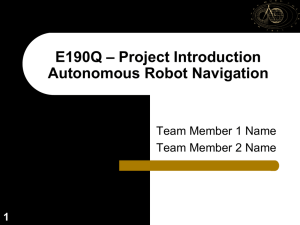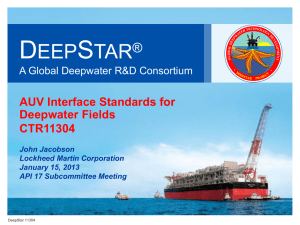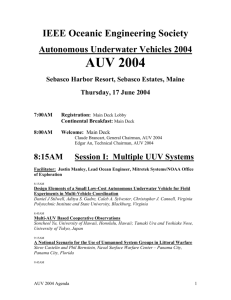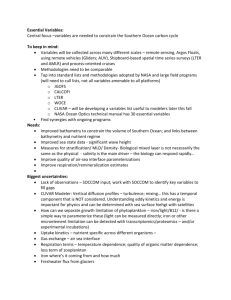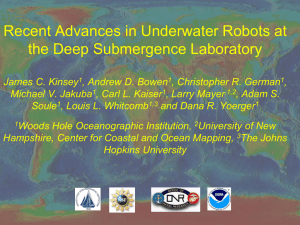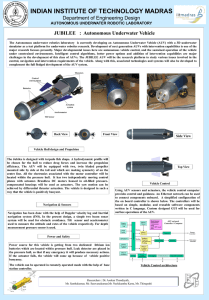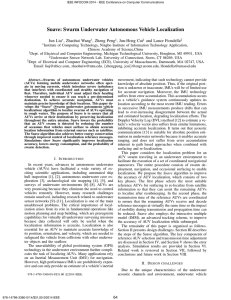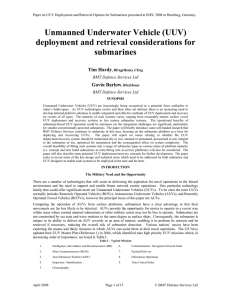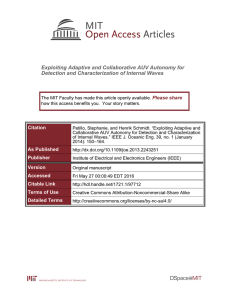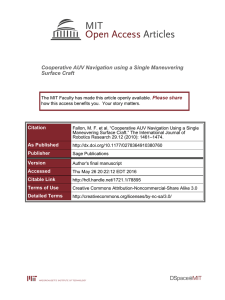Appendix D: Developments in AUV/ROV Technology
advertisement
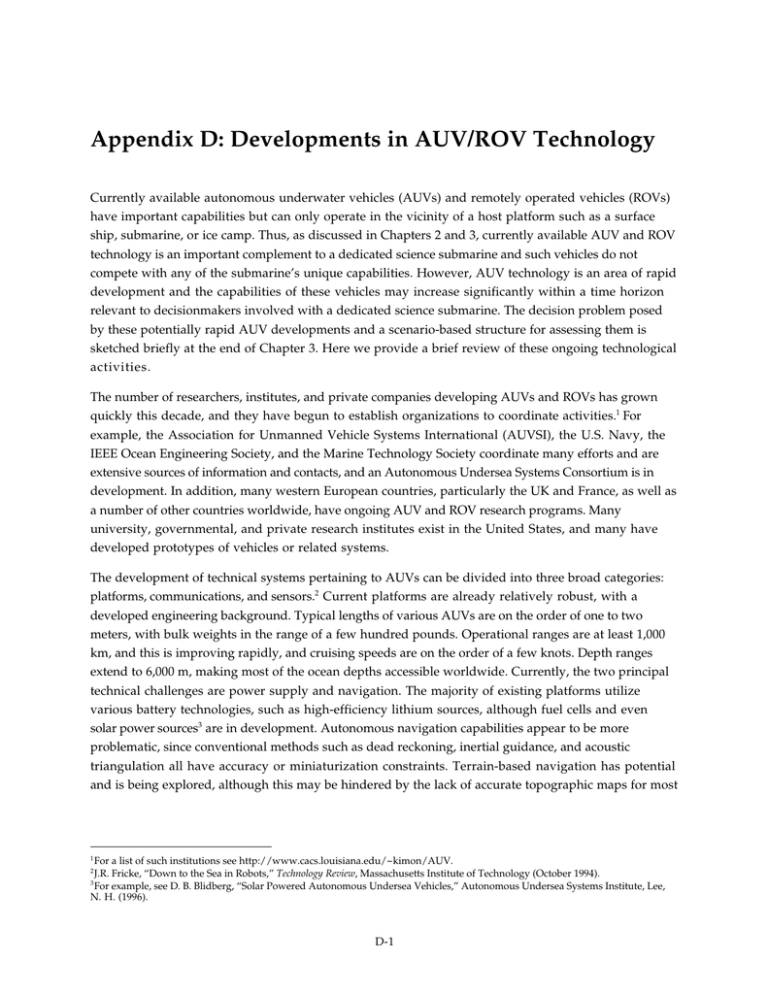
Appendix D: Developments in AUV/ROV Technology Currently available autonomous underwater vehicles (AUVs) and remotely operated vehicles (ROVs) have important capabilities but can only operate in the vicinity of a host platform such as a surface ship, submarine, or ice camp. Thus, as discussed in Chapters 2 and 3, currently available AUV and ROV technology is an important complement to a dedicated science submarine and such vehicles do not compete with any of the submarine’s unique capabilities. However, AUV technology is an area of rapid development and the capabilities of these vehicles may increase significantly within a time horizon relevant to decisionmakers involved with a dedicated science submarine. The decision problem posed by these potentially rapid AUV developments and a scenario-based structure for assessing them is sketched briefly at the end of Chapter 3. Here we provide a brief review of these ongoing technological activities. The number of researchers, institutes, and private companies developing AUVs and ROVs has grown quickly this decade, and they have begun to establish organizations to coordinate activities.1 For example, the Association for Unmanned Vehicle Systems International (AUVSI), the U.S. Navy, the IEEE Ocean Engineering Society, and the Marine Technology Society coordinate many efforts and are extensive sources of information and contacts, and an Autonomous Undersea Systems Consortium is in development. In addition, many western European countries, particularly the UK and France, as well as a number of other countries worldwide, have ongoing AUV and ROV research programs. Many university, governmental, and private research institutes exist in the United States, and many have developed prototypes of vehicles or related systems. The development of technical systems pertaining to AUVs can be divided into three broad categories: platforms, communications, and sensors.2 Current platforms are already relatively robust, with a developed engineering background. Typical lengths of various AUVs are on the order of one to two meters, with bulk weights in the range of a few hundred pounds. Operational ranges are at least 1,000 km, and this is improving rapidly, and cruising speeds are on the order of a few knots. Depth ranges extend to 6,000 m, making most of the ocean depths accessible worldwide. Currently, the two principal technical challenges are power supply and navigation. The majority of existing platforms utilize various battery technologies, such as high-efficiency lithium sources, although fuel cells and even solar power sources3 are in development. Autonomous navigation capabilities appear to be more problematic, since conventional methods such as dead reckoning, inertial guidance, and acoustic triangulation all have accuracy or miniaturization constraints. Terrain-based navigation has potential and is being explored, although this may be hindered by the lack of accurate topographic maps for most 1 For a list of such institutions see http://www.cacs.louisiana.edu/~kimon/AUV. J.R. Fricke, “Down to the Sea in Robots,” Technology Review, Massachusetts Institute of Technology (October 1994). 3 For example, see D. B. Blidberg, “Solar Powered Autonomous Undersea Vehicles,” Autonomous Undersea Systems Institute, Lee, N. H. (1996). 2 D-1 of the Earth’s seafloor. However, even modest improvements in autonomous navigation capabilities could yield significant improvements in AUV capabilities. Perhaps the greatest increase in the capabilities of AUVs could come from developments in communications and networking. Since electromagnetic signals propagate poorly in the ocean, subsurface communications have conventionally relied on acoustics. Recent research has produced digital acoustic transmission systems, capable of compensating for the changing characteristics of the propagation channel, which can transmit at greater than 1,200 baud, and much higher rates are possible in the near future. Further performance increases may be obtainable by integrating many AUVs into acoustic local area networks (ALANs), much like cellular phone systems, and providing either floating or shorebased electromagnetic links to radio or satellite systems. Such system architecture can provide rapid, worldwide communications and the potential capability to control the operations of large numbers of AUVs remotely through the Internet from a researcher’s desktop. Small prototype ALAN systems have already been tested in open-ocean research. ALANs can also provide the potential to perform synoptic ocean measurements over large areas, and for automated platform control of multiple AUVs via distributed artificial intelligence methods. The third area of AUV technology required for their role in oceanographic operations is onboard sensors. Size, weight, and power constraints of the sensors are the significant engineering concerns, as are the typical temperatures and pressures which submersibles can be subjected to in the ocean. However this technology is developing dramatically. Chemical sensors based on tiny fiber optic probes, and silicon-chip based detectors for amino acids, are already being tested, and can detect the presence of a large variety of chemical and biological compounds. In general, sonar technology is already well developed for various platform types including AUVs, however simulating large synthetic acoustic arrays using fleets of highly mobile AUVs could provide rapid, high-resolution acoustic mapping and survey of large areas of the ocean. A variety of small, autonomous, low-power physical oceanographic instruments now exist which can be carried by AUVs, and are capable of measuring temperature, salinity (via conductivity), depth, currents, and small-scale turbulence. Again, data sharing and networking of many AUVs distributed over large physical areas could provide the capability to make in situ, synoptic measurements of ocean variables with a speed and resolution beyond any current capabilities. An interesting example of AUV technology for Arctic applications is being developed by a group led by James Bellingham at the Monterey Bay Aquarium Research Institute. This group has designed a stateof-the-art AUV-sensing platform for use in the Arctic, specifically to measure hydrography and track the warm Atlantic water intrusion into the Arctic Basin (the ALTEX experiment). This platform has a modular design with an articulated tail section, is only about 0.5 m in diameter, and is powered by an aluminum/peroxide fuel cell. Operational characteristics include a range of up to 1,400 km, a cruising speed of up to three knots, and a depth rating of 4,500 m, and it will be capable of fully autonomous operations for up to two weeks. The most novel characteristic of this design is its communications system, facilitated by 14 expendable telemetry buoys. After acquiring hydrographic data, the AUV downloads the data to a buoy, which is released and ascends to the ice interface, melts through the ice using an exothermic chemical, obtains a GPS position fix, then transmits all data to the Argos satellite. D-2 In this way, the AUV is capable of making full water column hydrographic assessments and transmitting them on a daily basis, for up to two weeks. All of the mechanical components of ALTEX AUV have been successively tested. In spring 2000, the fuel cell was successfully run for 170 hours. There was a separate successful test of the systems for melting through ice to allow satellite communications. There will be continued testing of the fuel cell through next spring, 2001, with the goal of operating for 340 hours. The full unit will be tested, along with the navigation systems, in the Arctic in 2001, deployed from the icebreaker Healey, on one of its first research cruises. In the past 2–3 years, the first scientific papers were published using AUV data. A recent report from the National Research Council made broad recommendations promoting AUV development for oceanographic research. There are seven commercial companies selling off-the-shelf AUV systems for a wide range of applications. There appears to be much interest among the scientific community in the capability of AUV developments to address important research problems. Given the above technical and operational capabilities that could be available within a few years, a large number of practical applications for AUVs have already been proposed. These include: in prospecting, facility construction, and equipment inspections for the underwater petroleum production industry; monitoring, tagging, and even acoustic herding of fish stocks; and detection of toxic algal blooms in the shellfish industry; monitoring and mapping pollutant distributions, such as oil spills, sewage, and radioactive waste; routine, high-resolution, and large-scale weather monitoring using meteorological packages to assess the ocean/atmosphere interface; routine monitoring and assessment of deep ocean variables for global climate change; routine generation and updating of bathymetric charts and current maps; and any hazardous subsurface duty, such as salvage or emergency recovery. A important potential advantage that AUVs have in all of these applications is cost, with the cheapest vehicles currently costing tens of thousands of dollars. Mass production of these units in the future could lower even these costs significantly. AUV technology has many applications in the warm, ice-free oceanic regions, and could replace many costly conventional oceanographic platforms. However, they may be particularly valuable in the icecovered ocean areas, where operation of existing platforms other than a dedicated science submarine is difficult or even impossible. At present, scientific and programmatic collaborations are being considered between NASA, NOAA, the U.S. Coast Guard, and the NSF’s Polar Research Programs to share deep space unmanned probe technologies and deep ocean technologies, and to integrate these into existing oceanographic support infrastructures. Potential plans include regional deployment of large numbers of ROVs and AUVs from icebreakers and by airdrop; small unmanned docking stations to provide onsite power regeneration and satellite communication links; equipping of autonomous platforms with a variety of recently developed miniaturized and low-power sensors for physical, chemical, and biological measurements; advanced, integrated acoustic and electromagnetic communications networks to provide remote control and large-scale areal sensing; and seamless computer/human network interfaces whereby human operators at very remote locations can control platform operations in near–real time. D-3 The full development of the above technologies may make possible the cost-effective study and monitoring of a large number of important physical and biochemical processes in both Arctic and Antarctic regions.4 For example, monitoring of temperature, salinity and currents on fine physical (submeter) and temporal scales; the study of hydrothermal vent systems; surveying of methane hydrate deposits; surveys of under-ice biological processes and productivity; studies of benthic processes; monitoring particulate fluxes (especially carbon) and fluxes of various gases—particularly carbon dioxide; bathymetric surveys; characterizing ocean acoustic properties; measurement of glacial retreat in shallow water regions; and perhaps most importantly large-scale surveys of ice volume and studies of ice dynamics, which may have critical importance to the Earth’s climate. Many of the technologies required to perform these various tasks exist now, and many may be well developed within a decade. One of the main uncertainties governing the rate of AUV development is the level of funding for such efforts which will be made available by the government. 4 “Science at the Extremes,” report of the Arctic and Antarctic Undersea Workshop, April 15–17, 1998, sponsored by NOAA, NASA, and USCG. D-4
